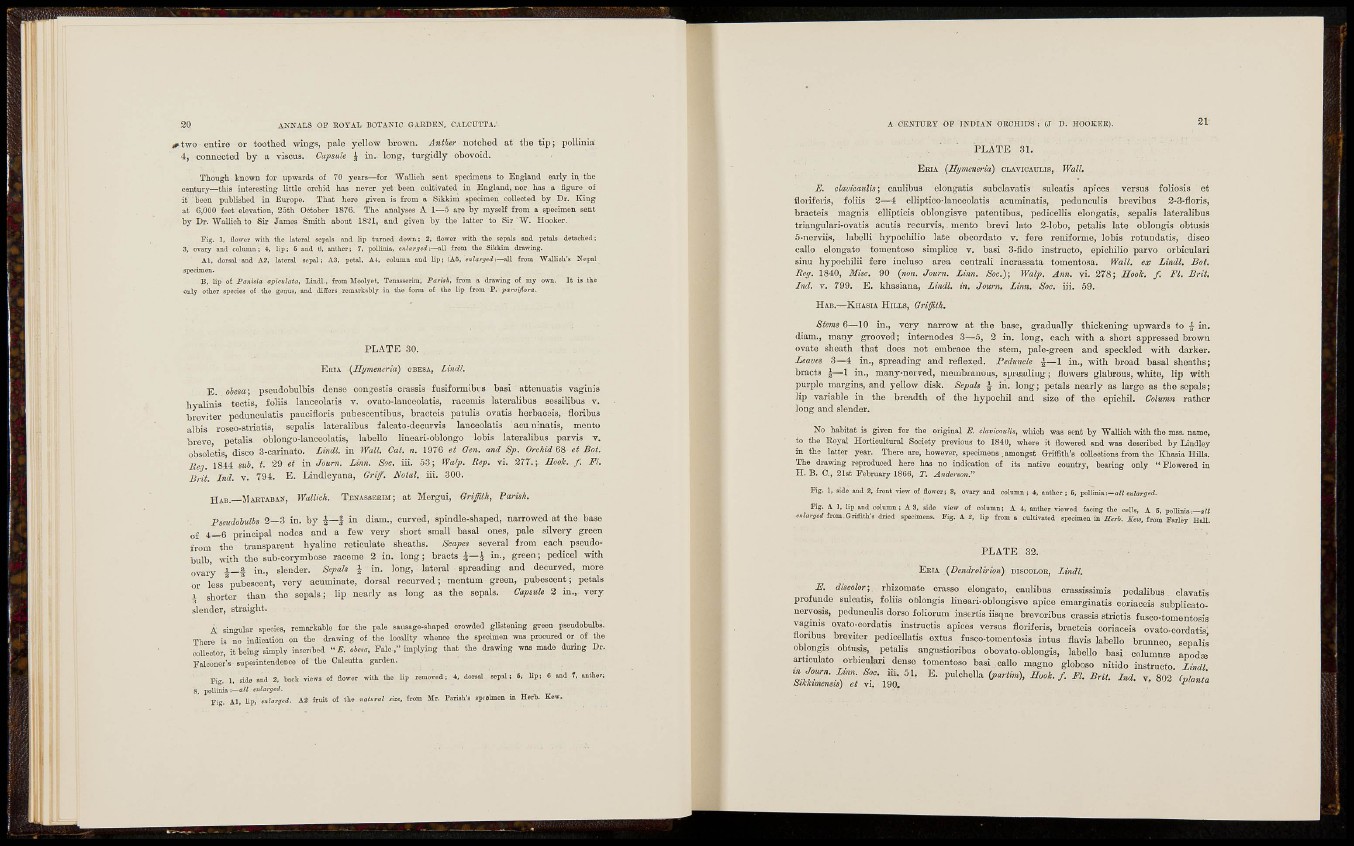
2 0 AXKALS OP ROYAL BOTANIC G.UIDEN, CALCUTTA.
»two entire or toothed wings, palo yellow brown. Anther notched at the tip; pollinia
4, connected by a viscus. Capsule ¿ in. long, turgidly obovoid.
Though known ior upwards of "0 years—tor "WalHoh sent specimens to England early in the
eantury—tliia iuteresting little orchid has never yet been ciiltivated in England, nor has a figure of
it been pubhshed in Exirope. That here given is from a Sikkim specimen collected by Dr. King
a t 6,000 feet elevation, 25th October 1876. The analyses A 1—5 are by myself from a specimen sent
b y Dr. Wallich to Sir James Smith about 1821, and given by the latter to Sir "W. Hooker.
Pig. 1, flowor with tlie latoral sepals nnd lip turned down i 2, flower witii tlic sepals and petals detnchod;
3, OTary and column; 4, lip; 5 and Ü, anther; 7, pollinia, ««Zai-jferf:—all from tlio Silikim drawing.
Al, dorsal and Ai, lateral sapal; A3, petal, AJ, column and lip; 1A5, enlarged-.—eh from Wallieli's Nepal
specimen.
B, lip oE Panisia apiculata, Lindl., from Moolyct, Tcnnsscrim, Parhk, from a drawing of my own. It ia tke
only otlier species of the gjnus, and differs remackably in tlio foi-m o£ tUo lip from P. parvijlora.
PLATE 30.
E RIA [Eymencria) obesa, Lindi.
E obesa', psoudobulbis dense congestis crassis fusiformibvs basi attenuatis vaginia
hyalinis tectis, foliis lanceolaris v. ovato-lanceolatis, raeemis lateralibus sessilibus v.
breviter pedunculatis paucifloris pubesceutibus, bracteis patulis oratia herbacais, floribas
albis roseo-stiiatis, sepalis lateralibus falcato-deourvis lanceolati« acuninatis, mento
breve petalis oblongo-lanceolatis, labello lineari-oblongo lobis lateralibus parvis t.
obsolètis, disco S-earInato. Lindi, in Wall. Cat. n. 1976 et Gen. and Sp. Orchid et Boi.
Reg. 1844 sub. t. 29 et in Joum. Linn. Soc. iii. 53; Walp. Rsp. vi. 277.; Hook. f . FI.
Bri't. Ind. v. 794. E. Lindleyana, Grif. Notai, iii. 300.
jj^b—Maktabax, WalUch. Tesassgrim; at Mergui, Gripk, Parish.
Pseudohulbs 2—3 in. by i—| in diam., curved, spindle-shaped, narrowed at the base
of 4_6 principal nodes and a few very short small basal ones, pale silvery green
from the transparent hyaline reticulate sheaths. Scapes several from each pseudobulb,
with the sub-coryoibose raceme 2 in. long ; bracts i—i in., green ; pedicel with
in., slender. Sepah ^ in. long, lateral spreading and decurved, more
or less pubescent, very acuminate, dorsal recurved; mentum green, pubescent; petals
1 shorter than the sepals; lip nearly as long as the sepals. Capsule 3 in., very
slender, straight.
A sm-nilar species, remarkable for the pale sausage-shaped crowded glistening green ;
There is no indication on the drawing of the locality whence the specimen was procured or of the
collector, it being simply inscribed " obesa, Falc-," hnplying that the drawing was made during Dr.
Falconer's supeiintendence of the Calcutta garden.
Fig. 1, side and 2, hack views of flower with the lip removed; i. dorsal sopil; 6. lip; 6 and 1, anther;
ze, from Mr. Parish's specimen in Herb. Kew.
8, pollinia enlarged.
Fig. Al. lip. enlarged. A2 fruit o£ the natural t
A CENTURY OF INDIAN ORCHIDS ; (J D. HOOKER).
P L A T E 31.
E r i a (Jlpncnefia) clavicaulis, Wall.
E. clavieaiiUs caulibus elongatis subclavatis sulcalis apices versus foliosis et
iloiifeiis, foliis 2—4 elliptico-lanceolatis acuminatis, pedunculia brevibus 2-3-floris,
bracteis magnis elHpticis oblongisve patentibus, pedicellis elongatis, sepalis lateralibus
triangulari-ovatis acutis rocurvi'j, mento brevi lato 2-lobo, petalis late oblongis obtusis
5-nerviÌ8, 1 abolii hypochilio late obcordato v. fere reniforme, lobis rotundatis, disco
callo elongato tomentoso simplice v. basi 3-fido instructo, epichilio parvo orbiculari
sinu hypochilii fere incluso area centrali incrassata tomentosa. Wall, ex Lindl. Boi.
Reg. 1840, Misc. 90 {non. Joum. Linn. Soc.)] Walp. Ann. vi. 278; Hooìc. f . FI. Brit.
Lid. V. 799. E. khasiana, Lindl. in. Joum, Linn. Soc. iii. 59.
E a b . — K h a s i a Hi l l s , Griffilh.
Stems 6—10 in., very narrow at the base, gradually thickening upwards to ^ in.
diam., many grooved; intemodes 3—5, 2 in. long, each with a short appressed brown
ovate sheath that does not embrace the stem, pale-green and speckled with darker.
Leaves 3—4 in., spreading and reflexed. Peduncle i—1 in., with broad basal sheaths;
bracts a—1 in., many-nerved, membranous, spreading ; flowers glabrous, white, lip with
purple margins, and yeUow disk. Sepah A in. long; petals nearly as large as the sepals;
lip variable in the breadth of the hypochil and size of the epichil. Column rather
long and slender.
No habitat is given for the original E. clavionuUi, which was sent by Wallich with the mss. name,
to the Royal Hortioultural Society previous to 1840, where it flowered and was described by Lindley
i n the latter year. There are, however, specimens .amongst Griffith's coEootions from the Khasia, Hills.
The drawing reproduced here has no indication of its native country, bearing only "Flowered in
n . B. C., 21sfc February 1866, T. Anderson."
Pig. 1, side and 2, front view of flower; 3, orary and column ; 4, anther ; 5, pol l iniae n l a r g e d .
Fig. A 1, lip and column ; A 3, side view of column; A 4, anfher viewed facing the cells, A 5, pollinia—a?/
enlarged from Griffith's dried specimens. Fig. A 2, lip from a cultivated specimen in Eerb. Kexo, from Farley HoU.
P L A T E 32.
Eeu {Dendrolirion) discolor, Lindl.
E. discolor] rhizomate cmsso elongate, caulibus crassissimis pedalibus clavatis
profunde sulcatis, foliis oblongis lineari-oblongisve apice emarginatis coriaceis subplicatoncrvosis,
pedunculis dorso foliorum insertis iisque brevoribus crassis strictis fusco-tomentosis
vagmis ovato-cordatis instructis apices versus floriferis, bracteis coriaceis ovato-cordatis'
lionhus breviler pedicellatis extus fusco-tomentosis intus flavis labello brunneo, sepalis
oblongis obtusis, petaUs angustioribus obovato-oblongis, labello basi column^e apod®
articulate orbicdari dense tomentoso basi callo magno globoso nitido instructo. Lindi
^n Journ. L^nn Soc. 51. E. pulchella Hook. f . FI. BriU In4. v. 803 (tlnÌ
' et vi» 190»